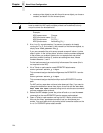
217
12 Novell Configuration For
10/100Base-T Interfaces
Overview
This chapter provides additional information for Novell environments using the
10/100Base-T interface, including:
1. NIC Configuration. This section includes information about setting the
preferred file server; setting password security; adjusting polling time;
changing the NIC name; changing the NIC frame type; changing the NIC
mode; setting the NIC NDS context; and setting the NIC preferred NDS
tree.
2. Host Configuration. This section includes information about the NDS
PSERVER setup; Bindery PSERVER setup; referencing a Bindery queue
in NDS; and RPRINTER/NPRINTER setups.
3. Troubleshooting tips. This section covers PSERVER setups,
RPRINTER/NPRINTER setups, and printing related problems.
Novell NIC Configuration (10/100Base-T)
There are no mandatory Novell settings needed before the print server can be
detected on the network. However, there can be some mandatory settings
needed before a Novell print queue can be serviced by the NIC. These
mandatory settings are covered separately for Netware 3.x, 4.x, and 5.x under
the Host Configuration heading.
The print server setup in a Novell environment is much simpler than that
required in a TCP/IP one. No addresses, masks, or router entries are
necessary, and, in most cases, the NIC can simply be connected to the
network, turned on, and then configured for printing from a Novell station
through PCONSOLE or Netware Administrator. See Figure 21 for an example
of a Novell network which shows the use of file servers and how they relate to
the print server.
There are, however, some optional parameters you may wish to change such
as the preferred file server(s), print server password, polling time, frame type,
print server name, NDS context, and NDS preferred tree. The following
sections describe these optional parameters.


















